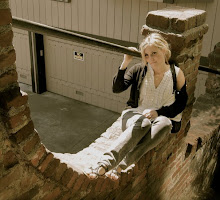
Sadly, I now find myself in Peet’s Coffee in Santa Barbara, CA, staring at my computer screen ready to detail four historic days in the German capital. The sad part is not that I am finally enjoying a delicious (and much missed) cup of Peet’s coffee, but that I am back home, the adventure over, and work to return to. It’s true what they say, that all good things must come to an end, huh?
Instead of remembering the construction and traffic on my way here this morning, or the cold front of only English that greeted me when I opened the door, I will close my eyes and picture myself on the train from Prague to Berlin, arriving in the magnificent Berlin Haupbahnhof—welcomed by four levels of steel and glass, restaurants and stores, and of course German. Yes, a much better picture. And now, let me recount the journey.
After Jason and I checked into the 3 Little Pig’s Hostel (located quite near the action of the November 9th celebrations), we headed off to see the sights of Berlin’s Western centre. On our way, I told him about my conversation with the girl at the front desk. When my affirmative nod answered her question if we were in Berlin for the anniversary celebrations, she said, “I have never seen the city this crowded. I mean, well, maybe for the Berlin Love Parade, but still, it is really bad out there right now”. Not fully knowing the chaos that we were getting ourselves into, Jason and I continued our fast-paced walk through the city’s Kulturforum with its grand Philharmonie and Gemldegalerie. We were also able to walk down Stauffenbergstrasse—the location of the Bendlerblock. Built during the Hitler’s Third Reich, this collection of buildings became the headquarters of the German Army during WWII. It was also the location of where Claus Schenk von Stauffenberg and his conspirators were shot after a failed assassination attempt on Hitler (the plot of Valkyrie).
I then led Jason through Berlin’s beautiful Tiergarten (largest landscaped garden within a city in all of Europe) on our way to the Kaiser-Wilhelm-Gedachtnis Kirche. This church is truly one of Berlin’s unique landmarks. It was destroyed by bombs in 1943, and after the rubble was cleared, only the front tower remained with its bombed out roof. (I still think the best way to describe the roof is to picture an icecream cone turned upside down with the tip broken off). Being inside a bombed out church was really incredible, and brought me back to my last visit to this church as well as to my time spent in Coventry, England, the church there, and the pact made between destroyed churches in England and Germany after the war toward peace and reconciliation since once-enemies were still members of one believing body.
Although it was completely dark by the time we left the church, the night was quite young (as in 5pm), and Jason and I decided to head toward Potsdamer Platz—Berlin’s new financial and business district, and crowded with people. We soon came face-to-face with these huge white wall pieces all hand-painted by various schools and other institutions across Germany. From where we stood we could look down the entire street to the Brandenburg Gate (the symbol of division and reunification between East and West), seeing only the domino-line—a mere fraction of the 1000 piece set that followed the actual line of the Berlin Wall. The slow walk down the street was incredibly inspiring. Each “wall” segment depicted a different scene and message about the fall of communism, the division of a city, the strength and courage of a people, and/or a note of appreciation to the countries involved in the Soviet downfall. On our way to the purple lit Brandenburg Gate (with what seemed to be lasers of white light shooting out from each of the four copper green horses on top), we passed the dark, barely lit 2,711 stone blocks of varying sizes that make up Berlin’s controversial Memorial to the Murdered Jews of Europe. A brief detour away from our 1989 mindset brought us back to the Holocaust as we walked through the maze of concrete that resembled a mix between graves, cell blocks, or cattle cars depending on one’s perspective, and we remembered another event of Berlin’s darker history. (Historical side note: November 9, 1938 was the date of the Kristallnacht pogrom in Germany or the “Night of Broken Glass” where Nazis and German citizens lashed out on the Jewish community, destroying 101 synagogues, 7,500 Jewish businesses, and arresting 26,000 Jews who were subsequently sent to concentration camps. 91 Jews died of injuries received from physical attacks. The German Chancellor Angela Merkel made sure to somberly mention that anniversary as well when she spoke inspiringly of the anniversary of the wall’s fall.)
After contemplating the past interrupted by the occasional artistic picture, we continued our journey to the gate and its light show. When we arrived, the gate was blocked by security, a concert of sorts about to begin. What we did not realize, was that we had walked into the practice session for the next night’s events. And when the guy on stage started singing, “We weren’t born to follow”, Jason deduced, “he sounds like a German Bon Jovi”. (Only later, when we came across a program for the 9th which reported an 8:30pm showing of Bon Jovi and his “We Weren’t Born to Follow” playing in front of the Reichstag, did we laugh at our deductions). Cold and hungry (but very excited), we left the chaos and found a nice, warm Italian restaurant in Alexanderplatz. A return to the hostel followed, although—too overwhelmed by Berlin—sleep did not….

No comments:
Post a Comment